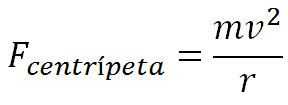
Centripetal force is a physical concept that plays a crucial role in kinematics and, in particular, in circular motion.
Despite its importance in understanding everyday and natural phenomena, it is often misunderstood or confused with centrifugal force.
In this article, we will explain what centripetal force is with some examples in everyday life that will help you better understand its meaning.
Definition: What is centripetal force?
 Centripetal force is a force that acts on an object moving along a circular path. Its direction always points towards the center of the circle in which the object is moving. This force is necessary to keep the object moving in a circular path instead of moving in a straight line.
Centripetal force is a force that acts on an object moving along a circular path. Its direction always points towards the center of the circle in which the object is moving. This force is necessary to keep the object moving in a circular path instead of moving in a straight line.
It is often confused with the definition of "centrifugal force", but it is important to understand that centrifugal force is rather an apparent illusion caused by the inertia of objects in circular motion.
6 Examples of Centripetal Force
Centripetal force is a fundamental part of many aspects of everyday life and modern technology.
Here are some notable examples:
1. Vehicles on curves
When a car travels through a curve in the road, it experiences a centripetal force that keeps it on track. The centripetal force required depends on the speed of the car, the radius of the curve, and the mass of the vehicle.
In the case of a train taking a curve, the rails exert a lateral force on the flanges of the wheels of the cars, forcing them to change their path.
2. Roller coasters
Another good example can be seen in roller coasters: As a roller coaster car travels through loops and turns, it experiences centripetal forces that keep it moving along the track.
The fun and excitement of a roller coaster is due, in part, to these controlled centripetal forces.
3. Cycling and motorcycling
 Cyclists and motorcyclists rely on centripetal force to keep them in position when cornering. Leaning toward the inside of the turn allows centripetal force to balance the rider's inertia, keeping them on the road without falling off.
Cyclists and motorcyclists rely on centripetal force to keep them in position when cornering. Leaning toward the inside of the turn allows centripetal force to balance the rider's inertia, keeping them on the road without falling off.
4. Centrifuges
Centrifuges are devices used in laboratories and industry to separate components of a mixture based on their density.
Centripetal force is applied to the rotating sample, causing heavier particles to move to the bottom and lighter particles to move to the top, thus allowing separation.
5. Satellites and spacecraft
Satellites and spacecraft in orbit around Earth or other celestial bodies are examples that rely on centripetal force to keep them in their orbits. This force counteracts gravitational attraction and allows space objects to remain in constant orbital motion and is an important component in the study of astronomy.
6. Wind turbines
Wind energy is a type of energy that converts wind energy into electricity. This function is performed by wind turbines whose blades must be designed taking into account the centripetal force they will have to withstand when they are rotating at full capacity.
7. Cyclones and tornadoes
Cyclones and tornadoes are rotating weather systems that form due to centripetal force. The rotation of the Earth, along with other meteorological factors, creates these impressive natural phenomena.
Centripetal force formula
The centripetal force is calculated by the following equation:

Where:
-
Fc is the centripetal force.
-
m is the mass of the moving object.
-
v is the tangential velocity of the object.
-
r is the radius of the circular path.
This equation shows that the centripetal force is directly proportional to the mass of the object and the square of its tangential velocity. Furthermore, the centripetal force is inversely proportional to the radius of the circular path.
In other words, the higher the tangential velocity or the smaller the radius, the greater the centripetal force required to keep the object in its circular orbit.
The origin of centripetal force
Centripetal force has its roots in the fundamental laws of physics, in particular Newton's second law. According to this law, the acceleration of an object is directly proportional to the applied force and inversely proportional to its mass.
In the context of circular motion, this translates into a need for a net force toward the center of the circle to vary the rectilinear path.
To better understand this concept, let's consider the classic example of a spinning string with a mass attached to the end. As the object at the end of the string spins, it experiences a centripetal force that keeps it in its orbit.
This force originates from the tension in the string and acts as a net force directed toward the center of the circle of rotation.
Application in the nuclear industry
 In nuclear industry, these types of forces are also used to obtain nuclear fusion reactions. In a nuclear fusion reactor, centripetal force plays an essential role in reactors based on inertial or magnetic confinement.
In nuclear industry, these types of forces are also used to obtain nuclear fusion reactions. In a nuclear fusion reactor, centripetal force plays an essential role in reactors based on inertial or magnetic confinement.
In the specific case of magnetic confinement reactors, such as the tokamak, magnetic fields generate centripetal forces that help keep the charged plasma (a mixture of ions and electrons at high temperatures) confined in circular or helical paths within the reactor.
The goal is to prevent the plasma from touching the reactor walls, as this could cool it down and prevent fusion from occurring. These centripetal forces are generated to counteract the tendency of the plasma to expand due to the enormous pressures and temperatures generated inside it.